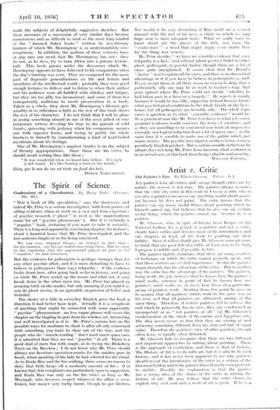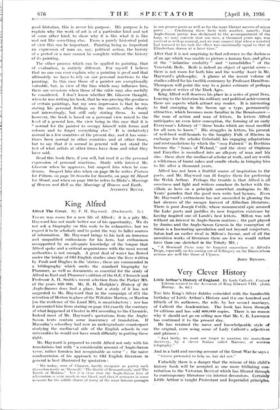Artist v. Critic
The Painter's Eye. By Edwin Claseow. (Faber. Os.) ALL painters hate all critics, and, savage though critics are by nature, the reverse is not true. The painter always assumes that the critic (by critic in this context I mean a critic WII0 is not also a painter) can never say anything useful about paint- ing because he does not paint. The critic knows that the painter can say many useful things about painting which he himself cannot say, but believes that he also can say certain useful things which the painter cannot say - -because he is a painter.
Mr. Glaseow, who, in spite of having been Keeper of the National Gallery for a period, is a painter and' not a eritie, clearly hates critics and devotes most of his introduction and one chapter, at least, of his book to pointing out I heir futility. Since it will no doubt give Mr. Glaseow some pleasure to think that one poor fish of a critic, at least, rose to his bait, I propose to nibble and, if possible, to bite.
The painter rightly maintains that there are ninny matters of technique on which the critic cannot properly speak, and that these matters are of vital importance. In this the painter unquestionably has the advantage of the critic. But in atiollur way the critic has the advantage of the painter. The painter, being inside the job, believes that he knows how the painter's mind works, whereas in point of fact he knows how one painter's mind works or, at .most, how those of a particular group of painters work. Starting from this point he goes on to assume that all painters' minds work in the same. way as his 'Own, RDA that all painters arc ultimately aiming at the same thing. Therefore, if certain painters fail to achieve the end which he personally has in view, they are condemned as incompetent or as " not painters at all " (rf. Mr. Glaseow's condemnation of the whole of Byzantine and Egyptian art). The idea never occurs to him that they are aiming at and achieving something different front his own end but of equal value. Therefore the painter's view of other painters, though often keen, is equally often distorted.
Mr. Glascow fails to recognise that there arc two different and important approaches to writing about painting. There is the approach of evaluation, anti there is that of history. The History of Art is to do with art, but it is also to do with history, and it has never been apparent to me why painter.; .should resent the interference of the critic in a section of the historical field in which the painter himself rarely even pretends to dabble. Possibly the explanation is that the painter has a wrong idea of the claims of the critic in writing the history of art. He may believe that the critic claims to explain why such and such a work of art is good. If he is a good historian, this is never his purpose. His purpose is to explain why the work of art is of a particular kind and not Of some other kind, to show why it is like what it is like and not like something else. From a purely historical point of view this can be important. Painting being as important an expression of man as, say, political action, the history of a period or a race cannot be complete without the history of its painting.
The other process which can be applied to painting, that of evaluation, is entirely different. For myself I believe that no-one can ever explain why a painting is good and that ultimately we have to rely on our personal reactions to the painting. In this ease those of a painter are exceptionally valuable, but, in view of the bias which may influence him, there are occasions when those of the critic may also usefully be considered. I don't know whether Mr. Glascow thought, when he was writing his book, that he was proving the goodness of certain paintings, but my own impression is that he was stating his personal feelings on the matter, often clearly and interestingly, but still only stating them. As usual however, the book is based on a personal view raised to the level of a general law, the view being in this case that it is " normal for the painter to occupy himself with forms and colours and to forget everything else." It is (relatively) normal in a few countries at the present day, and it has some- times been normal in other countries and at other times, but to say that it is normal in general will not stand the test of what artists at other times have done and what they have said.
Read this book then, if you will, but read it as the personal expression of personal reactions. Study with interest Mr. Glascow when he approves, but suspect him when be con- demns. Suspect him also when on page 30 he writes Pintura for Pitting, on page 70 Sessetta for Sassetta, on page 82 Monet for Monet, and when on page 160 he refers to Blake's Marriage Heaven and Hell as the Marriage of Heaven and Earth.
ANTHONY BLUNT.











































 Previous page
Previous page